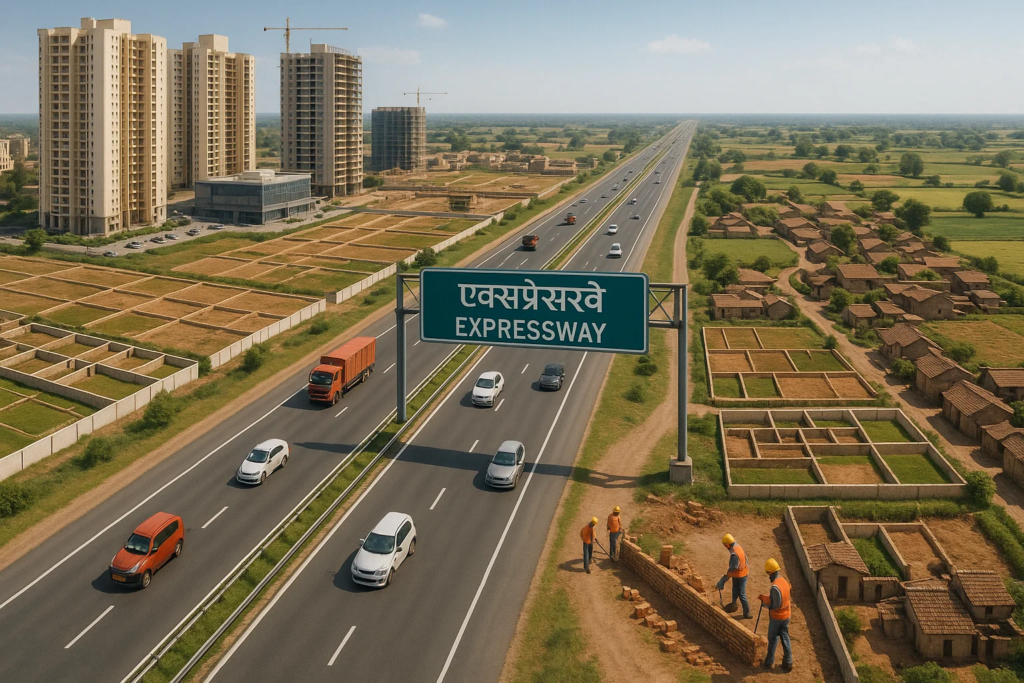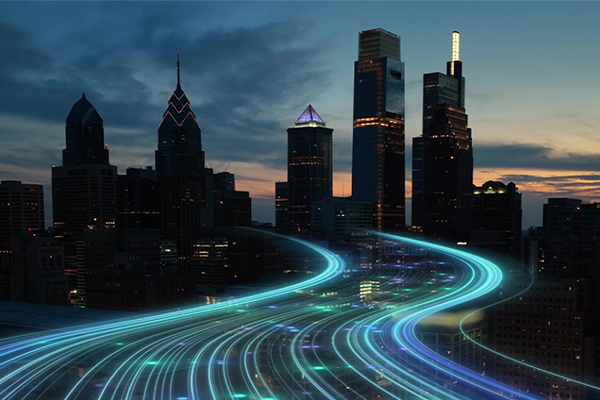Introduction
In India, expressway is changing the real estate environment fast. Not only are these high-speed corridors increasing the level of connectivity but they are also bringing new areas to urbanize, which is adding new potential investment locations in residential and commercial centers, logistics hubs, and industrial areas. This article discusses the active transformation of the real estate market in India through the real data and regional overview and investment advice on expressways.

Why Expressways Are Game-Changers in Real Estate
Expressways dramatically reduce travel times and open up new areas for real estate development. Here’s why they play such a critical role:
Improved Speed and Connectivity
Highways reduce the amount of time spent on travelling among major urban areas. In another example, inter-city travel via the Delhi Mumbai Expressway has been reduced to 12 hours, where travel hours previously took 24 hours; hence residential as well as commercial development is a boosted feature.
Alignment with Industrial Corridors
Expressways have been found to be closely linked with the national economic zone and industrial corridors in most urban studies in the contemporary world like in the case of the Delhi-Mumbai Industrial Corridor (DMIC). This kind of integration triggers the demand of land, warehouses, logistics parks and affordable housing.
Rise of Greenfield Developments
Within the modern rhetoric, researchers notice that the so-called greenfield expressways facilitate the formation of new urban centers. These large infrastructure projects attract residents who are ready to buy their initial living unit, attracts both government and private investment on complementary infrastructure and attracts developers who are interested in long term, sustainable development.
Social and Economic Upliftment
When cities are located in areas close to expressways as researchers of regional development have been observing, there are significant increases in labour-market access, educational opportunity and healthcare provision. This level of closeness makes the respective areas of residence especially more desirable to middle-income families and those who want to become middle-income or reach the same status. Therefore, the given localities present an ideal site of real-estate speculation and investment aimed at the mid-level section of the market.
Land Price Surge Along Expressways A Data Table
| Expressway Corridor | Time Period | Price Appreciation | Market Observation |
|---|---|---|---|
| Dwarka Expressway (Gurgaon) | 2020–2024 | 100% – 165% | Massive growth in premium housing |
| Delhi–Mumbai Expressway (NCR) | Pre-completion phase | 15% – 25% | Capital values rising in NCR towns |
| Bengaluru–Chennai Expressway | Since 2022 | Up to 25x | Industrial corridor + housing boom |
| Ganga Expressway (UP) | Emerging | Early-stage growth | Targeting industrial expansion |
| Samruddhi Mahamarg (Maharashtra) | 2025–2035 forecast | Up to 5.2x | Long-term appreciation expected |
Major Expressways Reshaping Real Estate
Dwarka Expressway (Delhi–Gurgaon)
The segment of 29 km of the Dwarka Expressway, north-west of Delhi links these two cities of Delhi: Dwarka, a sub-city of Delhi, and the sectors of new Gurgaon. There has been a twofold increase in property prices in the past four years with escalated demand in luxury homes, commercial centers and plotted developments.
- Over 50,000 residential units launched.
- Sectors 102–113 in Gurgaon have become hotspots.
- Proximity to the upcoming India International Convention Centre in Dwarka adds value.
Delhi–Mumbai Expressway
At 1,386 km, it’s India’s longest expressway connecting Delhi, Haryana, Rajasthan, Gujarat, Maharashtra, and Madhya Pradesh.
- Key nodes like Sohna, Dausa, and Alwar are becoming investment zones.
- NCR belt sees increasing demand for plotted developments.
- Land acquisition and road-facing commercial real estate are in high demand.
Bengaluru–Chennai Expressway
This greenfield expressway has brought unprecedented land value appreciation in Tamil Nadu and Karnataka.
- Industrial growth around Kolar and Sriperumbudur.
- Tata and other large corporations are setting up plants.
- Demand for plotted residential townships has increased 25x in some pockets.
Ganga Expressway (Uttar Pradesh)
Spanning 594 km, the Ganga Expressway will connect Meerut to Prayagraj through 12 districts in UP.
- Industrial parks planned along the corridor.
- Strong push for textile and pharma hubs.
- Real estate demand is growing in Tier 2 cities like Meerut, Agra, and Kanpur.
Samruddhi Mahamarg (Mumbai–Nagpur)
One of the most ambitious expressway projects in Maharashtra, aimed at linking Nagpur with Mumbai.
- Planned smart cities and Krushi Samruddhi Nagar townships along the route.
- Residential, commercial, and logistics growth in Nashik and Aurangabad.
- Long-term appreciation up to 5.2x projected by 2035.
Real Estate Segments Most Affected
Residential Projects
Expressways create new housing corridors by connecting suburbs to city centers.
- Affordable housing in peripheral towns (e.g., Sohna, Bhiwadi, Panipat).
- Luxury high-rises along Dwarka Expressway.
- Weekend/vacation homes gaining popularity in scenic regions like Alwar and Dausa.
Commercial and Office Spaces
Better accessibility boosts demand for retail and office spaces.
- Shop-cum-office (SCO) plots in New Gurgaon and Noida.
- Office space demand along Delhi–Mumbai Expressway.
- Commercial zones thriving near Navi Mumbai’s MTHL corridor.
Industrial and Warehousing
Industrial zones flourish near expressways due to ease of transportation.
- Logistics parks and warehousing near major corridors like Bangalore–Chennai.
- FMCG, e-commerce, and 3PL companies investing in facilities along expressways.
- Delhi NCR and Maharashtra seeing the highest demand for industrial plots.
Township and Plot Developments
Large townships are being planned along nearly every major expressway.
- Samruddhi Mahamarg: 19 smart townships proposed.
- Dwarka Expressway: Integrated plotted townships with clubhouses, schools, hospitals.
- Ganga Expressway: Townships aligned with industrial parks and manufacturing hubs.
Why Real Estate Developers Are Betting Big
High Return on Investment
Early-stage investments along expressways have yielded 100–2500% ROI in 3–5 years.
Government Infrastructure Backing
When infrastructure is backed by government funds and master plans, real estate projects are perceived as low-risk and attract more funding.
Large Undeveloped Land Parcels
Greenfield expressways unlock vast areas of land, ideal for large-format developments including SEZs, smart cities, and gated communities.
End-User and Investor Demand
From first-time buyers to HNIs and institutional investors, the range of property demand around expressways is broad and sustained.
Key Challenges and Risks
Land Acquisition Delays
Lengthy legal procedures, compensation issues, and disputes can delay projects significantly.
Environmental Clearances
Expressway routes sometimes pass through protected forests or wildlife corridors, which may face litigation or environmental objections.
Infrastructure Lag
Sometimes, expressway development outpaces civic infrastructure like water supply, sewage, schools, or hospitals. This can reduce real estate desirability in the early years.
Speculative Bubbles
Rapid price rises can create unsustainable booms. Buyers should analyze the real on-ground progress, not just marketing claims.
What the Future Holds for Expressway-Led Growth
Upcoming Projects to Watch
- Delhi–Dehradun Expressway: Promising for Uttarakhand and NCR real estate.
- Chennai–Salem Expressway: Boosts the industrial corridor in Tamil Nadu.
- Lucknow–Varanasi Expressway: Expected to push growth in eastern UP.
Tier 2 and Tier 3 Cities in Focus
Cities like Kanpur, Meerut, Nagpur, and Dausa will see faster growth as they lie directly on expressway networks and benefit from reduced travel time.
Smart Township Development
Integrated townships with schools, malls, offices, and hospitals will rise along expressways. Government incentives are expected for sustainable smart-city projects.
Rise of Expressway-Driven Micro Markets
New micro-markets are emerging around access points, toll plazas, and junction cities. These offer affordable investment opportunities for early movers.
Expressways as Real Estate Catalysts
Expressways are no longer just about travel—they are creating the blueprint for India’s urban future. By opening up new regions, driving infrastructure, and generating real estate demand across sectors, they’re enabling more equitable and efficient urbanization.




